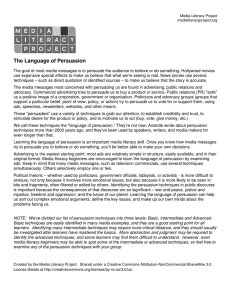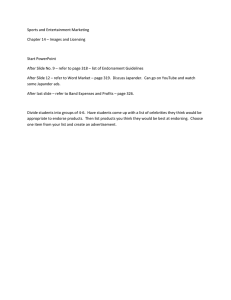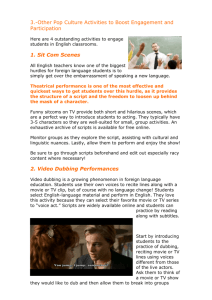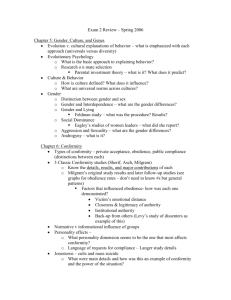Language of Persuasion
advertisement
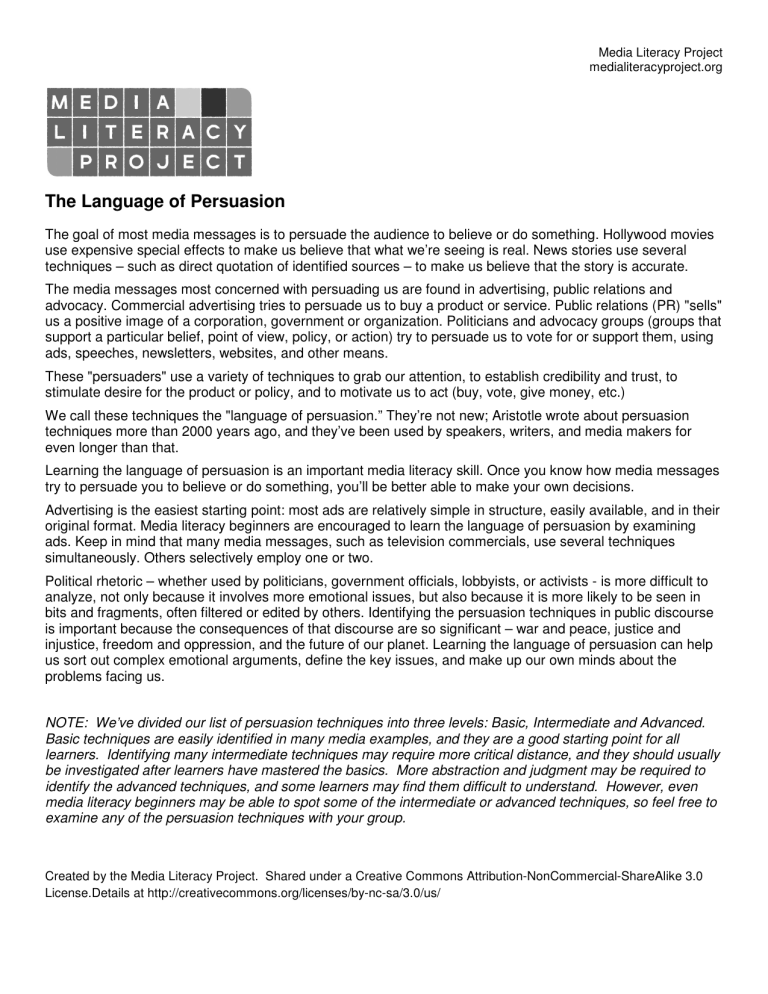
Media Literacy Project medialiteracyproject.org The Language of Persuasion The goal of most media messages is to persuade the audience to believe or do something. Hollywood movies use expensive special effects to make us believe that what we’re seeing is real. News stories use several techniques – such as direct quotation of identified sources – to make us believe that the story is accurate. The media messages most concerned with persuading us are found in advertising, public relations and advocacy. Commercial advertising tries to persuade us to buy a product or service. Public relations (PR) "sells" us a positive image of a corporation, government or organization. Politicians and advocacy groups (groups that support a particular belief, point of view, policy, or action) try to persuade us to vote for or support them, using ads, speeches, newsletters, websites, and other means. These "persuaders" use a variety of techniques to grab our attention, to establish credibility and trust, to stimulate desire for the product or policy, and to motivate us to act (buy, vote, give money, etc.) We call these techniques the "language of persuasion.” They’re not new; Aristotle wrote about persuasion techniques more than 2000 years ago, and they’ve been used by speakers, writers, and media makers for even longer than that. Learning the language of persuasion is an important media literacy skill. Once you know how media messages try to persuade you to believe or do something, you’ll be better able to make your own decisions. Advertising is the easiest starting point: most ads are relatively simple in structure, easily available, and in their original format. Media literacy beginners are encouraged to learn the language of persuasion by examining ads. Keep in mind that many media messages, such as television commercials, use several techniques simultaneously. Others selectively employ one or two. Political rhetoric – whether used by politicians, government officials, lobbyists, or activists - is more difficult to analyze, not only because it involves more emotional issues, but also because it is more likely to be seen in bits and fragments, often filtered or edited by others. Identifying the persuasion techniques in public discourse is important because the consequences of that discourse are so significant – war and peace, justice and injustice, freedom and oppression, and the future of our planet. Learning the language of persuasion can help us sort out complex emotional arguments, define the key issues, and make up our own minds about the problems facing us. NOTE: We’ve divided our list of persuasion techniques into three levels: Basic, Intermediate and Advanced. Basic techniques are easily identified in many media examples, and they are a good starting point for all learners. Identifying many intermediate techniques may require more critical distance, and they should usually be investigated after learners have mastered the basics. More abstraction and judgment may be required to identify the advanced techniques, and some learners may find them difficult to understand. However, even media literacy beginners may be able to spot some of the intermediate or advanced techniques, so feel free to examine any of the persuasion techniques with your group. Created by the Media Literacy Project. Shared under a Creative Commons Attribution-NonCommercial-ShareAlike 3.0 License.Details at http://creativecommons.org/licenses/by-nc-sa/3.0/us/ Media Literacy Project medialiteracyproject.org Basic persuasion techniques 1. Association. This persuasion technique tries to link a product, service, or idea with something already liked or desired by the target audience, such as fun, pleasure, beauty, security, intimacy, success, wealth, etc. The media message doesn’t make explicit claims that you’ll get these things; the association is implied. Association can be a very powerful technique. A good ad can create a strong emotional response and then associate that feeling with a brand (family = Coke, victory = Nike). This process is known as emotional transfer. Several of the persuasion techniques below, like Beautiful people, Warm & fuzzy, Symbols and Nostalgia, are specific types of association. 2. Bandwagon. Many ads show lots of people using the product, implying that "everyone is doing it" (or at least, "all the cool people are doing it"). No one likes to be left out or left behind, and these ads urge us to "jump on the bandwagon.” Politicians use the same technique when they say, "The American people want..." How do they know? 3. Beautiful people. Beautiful people uses good-looking models (who may also be celebrities) to attract our attention. This technique is extremely common in ads, which may also imply (but never promise!) that we’ll look like the models if we use the product. 4. Bribery. This technique tries to persuade us to buy a product by promising to give us something else, like a discount, a rebate, a coupon, or a "free gift.” Sales, special offers, contests, and sweepstakes are all forms of bribery. Unfortunately, we don’t really get something for free -- part of the sales price covers the cost of the bribe. 5. Celebrities. (A type of Testimonial – the opposite of Plain folks.) We tend to pay attention to famous people. That’s why they’re famous! Ads often use celebrities to grab our attention. By appearing in an ad, celebrities implicitly endorse a product; sometimes the endorsement is explicit. Many people know that companies pay celebrities a lot of money to appear in their ads (Nike’s huge contracts with leading athletes, for example, are well known) but this type of testimonial still seems to be effective. 6. Experts. (A type of Testimonial.) We rely on experts to advise us about things that we don’t know ourselves. Scientists, doctors, professors and other professionals often appear in ads and advocacy messages, lending their credibility to the product, service, or idea being sold. Sometimes, Plain folks can also be experts, as when a mother endorses a brand of baby powder or a construction worker endorses a treatment for sore muscles. 7. Explicit claims. Something is "explicit" if it is directly, fully, and/or clearly expressed or demonstrated. For example, some ads state the price of a product, the main ingredients, where it was made, or the number of items in the package – these are explicit claims. So are specific, measurable promises about quality, effectiveness, or reliability, like “Works in only five minutes!” Explicit claims can be proven true or false through close examination or testing, and if they’re false, the advertiser can get in trouble. It can be surprising to learn how few ads make explicit claims. Most of them try to persuade us in ways that cannot be proved or disproved. 8. Fear. This is the opposite of the Association technique. It uses something disliked or feared by the intended audience (like bad breath, failure, high taxes or terrorism) to promote a "solution.” Ads use fear to sell us products that claim to prevent or fix the problem. Politicians and advocacy groups stoke our fears to get elected or to gain support. Created by the Media Literacy Project. Shared under a Creative Commons Attribution-NonCommercial-ShareAlike 3.0 License.Details at http://creativecommons.org/licenses/by-nc-sa/3.0/us/ Media Literacy Project medialiteracyproject.org 9. Humor. Many ads use humor because it grabs our attention and it’s a powerful persuasion technique. When we laugh, we feel good. Advertisers make us laugh and then show us their product or logo because they’re trying to connect that good feeling to their product. They hope that when we see their product in a store, we’ll subtly re-experience that good feeling and select their product. Advocacy messages (and news) rarely use humor because it can undermine their credibility; an exception is political satire. 10. Intensity. The language of ads is full of intensifiers, including superlatives (greatest, best, most, fastest, lowest prices), comparatives (more, better than, improved, increased, fewer calories), hyperbole (amazing, incredible, forever), exaggeration, and many other ways to hype the product. 11. Maybe. Unproven, exaggerated or outrageous claims are commonly preceded by "weasel words" such as may, might, can, could, some, many, often, virtually, as many as, or up to. Watch for these words if an offer seems too good to be true. Commonly, the Intensity and Maybe techniques are used together, making the whole thing meaningless. 12. Plain folks. (A type of Testimonial – the opposite of Celebrities.) This technique works because we may believe a "regular person" more than an intellectual or a highly-paid celebrity. It’s often used to sell everyday products like laundry detergent because we can more easily see ourselves using the product, too. The plain folks technique strengthens the down-home, "authentic" image of products like pickup trucks and politicians. Unfortunately, most of the "plain folks" in ads are actually paid actors carefully selected because they look like "regular people.” 13. Repetition. Advertisers use repetition in two ways: Within an ad or advocacy message, words, sounds or images may be repeated to reinforce the main point. And the message itself (a TV commercial, a billboard, a website banner ad) may be displayed many times. Even unpleasant ads and political slogans work if they are repeated enough to pound their message into our minds. 14. Testimonials. Media messages often show people testifying about the value or quality of a product, or endorsing an idea. They can be experts, celebrities, or plain folks. We tend to believe them because they appear to be a neutral third party (a pop star, for example, not the lipstick maker, or a community member instead of the politician running for office.) This technique works best when it seems like the person “testifying” is doing so because they genuinely like the product or agree with the idea. Some testimonials may be less effective when we recognize that the person is getting paid to endorse the product. 15. Warm & fuzzy. This technique uses sentimental images (especially of families, kids and animals) to stimulate feelings of pleasure, comfort, and delight. It may also include the use of soothing music, pleasant voices, and evocative words like "cozy" or "cuddly.” The Warm & fuzzy technique is another form of Association. It works well with some audiences, but not with others, who may find it too corny. Intermediate persuasion techniques 16. The Big Lie. According to Adolf Hitler, one of the 20th century’s most dangerous propagandists, people are more suspicious of a small lie than a big one. The Big Lie is more than exaggeration or hype; it’s telling a complete falsehood with such confidence and charisma that people believe it. Recognizing The Big Lie requires "thinking outside the box" of conventional wisdom and asking the questions other people don’t ask. Created by the Media Literacy Project. Shared under a Creative Commons Attribution-NonCommercial-ShareAlike 3.0 License.Details at http://creativecommons.org/licenses/by-nc-sa/3.0/us/ Media Literacy Project medialiteracyproject.org 17. Charisma. Sometimes, persuaders can be effective simply by appearing firm, bold, strong, and confident. This is particularly true in political and advocacy messages. People often follow charismatic leaders even when they disagree with their positions on issues that affect them. 18. Euphemism. While the Glittering generalities and Name-calling techniques arouse audiences with vivid, emotionally suggestive words, Euphemism tries to pacify audiences in order to make an unpleasant reality more palatable. Bland or abstract terms are used instead of clearer, more graphic words. Thus, we hear about corporate "downsizing" instead of "layoffs," or "intensive interrogation techniques" instead of "torture.” 19. Extrapolation. Persuaders sometimes draw huge conclusions on the basis of a few small facts. Extrapolation works by ignoring complexity. It’s most persuasive when it predicts something we hope can or will be true. 20. Flattery. Persuaders love to flatter us. Politicians and advertisers sometimes speak directly to us: "You know a good deal when you see one." "You expect quality." "You work hard for a living." "You deserve it." Sometimes ads flatter us by showing people doing stupid things, so that we’ll feel smarter or superior. Flattery works because we like to be praised and we tend to believe people we like. (We’re sure that someone as brilliant as you will easily understand this technique!) 21. Glittering generalities. This is the use of so-called "virtue words" such as civilization, democracy, freedom, patriotism, motherhood, fatherhood, science, health, beauty, and love. Persuaders use these words in the hope that we will approve and accept their statements without examining the evidence. They hope that few people will ask whether it’s appropriate to invoke these concepts, while even fewer will ask what these concepts really mean. 22. Name-calling. This technique links a person or idea to a negative symbol (liar, creep, gossip, etc.). It’s the opposite of Glittering generalities. Persuaders use Name-calling to make us reject the person or the idea on the basis of the negative symbol, instead of looking at the available evidence. A subtler version of this technique is to use adjectives with negative connotations (extreme, passive, lazy, pushy, etc.) Ask yourself: Leaving out the name-calling, what are the merits of the idea itself? 23. New. We love new things and new ideas, because we tend to believe they’re better than old things and old ideas. That’s because the dominant culture in the United States (and many other countries) places great faith in technology and progress. But sometimes, new products and new ideas lead to new and more difficult problems. 24. Nostalgia. This is the opposite of the New technique. Many advertisers invoke a time when life was simpler and quality was supposedly better ("like Mom used to make"). Politicians promise to bring back the "good old days" and restore "tradition." But whose traditions are being restored? Who did they benefit, and who did they harm? This technique works because people tend to forget the bad parts of the past, and remember the good. 25. Rhetorical questions. These are questions designed to get us to agree with the speaker. They are set up so that the “correct” answer is obvious. ("Do you want to get out of debt?" "Do you want quick relief from headache pain?" and "Should we leave our nation vulnerable to terrorist attacks?" are all rhetorical questions.) Rhetorical questions are used to build trust and alignment before the sales pitch. Created by the Media Literacy Project. Shared under a Creative Commons Attribution-NonCommercial-ShareAlike 3.0 License.Details at http://creativecommons.org/licenses/by-nc-sa/3.0/us/ Media Literacy Project medialiteracyproject.org 26. Scientific evidence. This is a particular application of the Expert technique. It uses the paraphernalia of science (charts, graphs, statistics, lab coats, etc.) to "prove" something. It often works because many people trust science and scientists. It’s important to look closely at the "evidence," however, because it can be misleading. 27. Simple solution. Life is complicated. People are complex. Problems often have many causes, and they’re not easy to solve. These realities create anxiety for many of us. Persuaders offer relief by ignoring complexity and proposing a Simple solution. Politicians claim one policy change (lower taxes, a new law, a government program) will solve big social problems. Advertisers take this strategy even further, suggesting that a deodorant, a car, or a brand of beer will make you beautiful, popular and successful. 28. Slippery slope. This technique combines Extrapolation and Fear. Instead of predicting a positive future, it warns against a negative outcome. It argues against an idea by claiming it’s just the first step down a “slippery slope” toward something the target audience opposes. ("If we let them ban smoking in restaurants because it’s unhealthy, eventually they’ll ban fast food, too." This argument ignores the merits of banning smoking in restaurants.) The Slippery slope technique is commonly used in political debate, because it’s easy to claim that a small step will lead to a result most people won’t like, even though small steps can lead in many directions. 29. Symbols. Symbols are words or images that bring to mind some larger concept, usually one with strong emotional content, such as home, family, nation, religion, gender, or lifestyle. Persuaders use the power and intensity of symbols to make their case. But symbols can have different meanings for different people. Hummer SUVs are status symbols for some people, while to others they are symbols of environmental irresponsibility. Advanced persuasion techniques 30. Ad hominem. Latin for "against the man," the ad hominem technique responds to an argument by attacking the opponent instead of addressing the argument itself. It’s also called "attacking the messenger.” It works on the belief that if there’s something wrong or objectionable about the messenger, the message must also be wrong. 31. Analogy. An analogy compares one situation with another. A good analogy, where the situations are reasonably similar, can aid decision-making. A weak analogy may not be persuasive, unless it uses emotionally-charged images that obscure the illogical or unfair comparison. 32. Card stacking. No one can tell the whole story; we all tell part of the story. Card stacking, however, deliberately provides a false context to give a misleading impression. It "stacks the deck," selecting only favorable evidence to lead the audience to the desired conclusion. 33. Cause vs. Correlation. While understanding true causes and true effects is important, persuaders can fool us by intentionally confusing correlation with cause. For example: Babies drink milk. Babies cry. Therefore, drinking milk makes babies cry. 34. Denial. This technique is used to escape responsibility for something that is unpopular or controversial. It can be either direct or indirect. A politician who says, "I won’t bring up my opponent’s marital problems," has just brought up the issue without sounding mean. Created by the Media Literacy Project. Shared under a Creative Commons Attribution-NonCommercial-ShareAlike 3.0 License.Details at http://creativecommons.org/licenses/by-nc-sa/3.0/us/ Media Literacy Project medialiteracyproject.org 35. Diversion. This technique diverts our attention from a problem or issue by raising a separate issue, usually one where the persuader has a better chance of convincing us. Diversion is often used to hide the part of the story not being told. It is also known as a “red herring.” 36. Group dynamics. We are greatly influenced by what other people think and do. We can get carried away by the potent atmosphere of live audiences, rallies, or other gatherings. Group dynamics is a more intense version of the Majority belief and Bandwagon techniques. 37. Majority belief. This technique is similar to the Bandwagon technique. It works on the assumption that if most people believe something, it must be true. That’s why polls and survey results are so often used to back up an argument, even though pollsters will admit that responses vary widely depending on how one asks the question. 38. Scapegoating. Extremely powerful and very common in political speech, Scapegoating blames a problem on one person, group, race, religion, etc. Some people, for example, claim that undocumented (“illegal”) immigrants are the main cause of unemployment in the United States, even though unemployment is a complex problem with many causes. Scapegoating is a particularly dangerous form of the Simple solution technique. 39. Straw man. This technique builds up an illogical or deliberately damaged idea and presents it as something that one’s opponent supports or represents. Knocking down the "straw man" is easier than confronting the opponent directly. 40. Timing. Sometimes a media message is persuasive not because of what it says, but because of when it’s delivered. This can be as simple as placing ads for flowers and candy just before Valentine’s Day, or delivering a political speech right after a major news event. Sophisticated ad campaigns commonly roll out carefully-timed phases to grab our attention, stimulate desire, and generate a response. Created by the Media Literacy Project. Shared under a Creative Commons Attribution-NonCommercial-ShareAlike 3.0 License.Details at http://creativecommons.org/licenses/by-nc-sa/3.0/us/
